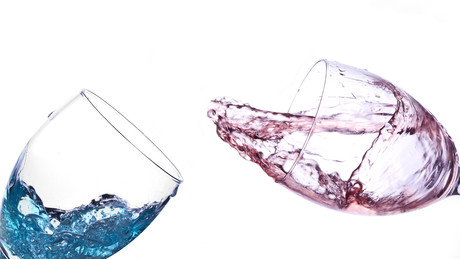Clutching at straws: the science of spill prevention

It doesn’t take a genius to know that if you knock a glass of water on its side, the liquid will spill out. However, if you happened to be drinking your water through a thin straw, some of the liquid will be retained within this straw — even when turned on its side.
But what is it exactly that makes this possible? Is it down to the size of the straw, its shape, its material or something else entirely? Seven years ago, Professor Andrew Parry, Dr Carlos Rascón and Professor Dirk Aarts began the calculations that would eventually provide them with the answer.
If you look closely at water in a glass, you can see the edges curve up slightly, so that the surface of the water looks like a shallow bowl. This is due to the force of surface tension, a phenomenon that determines how the liquid surface touches the sides of the glass. The majority of the liquid in the glass is not held this way, so that when the glass is tipped to the side, the force of gravity wins and all the liquid spills out.
On the other hand, if the diameter of the glass is small enough, such as in a very thin straw, then gravity is not able to overcome the forces of surface tension and the liquid remains within the tube. This is why drinking straws, or capillaries in pens, are only a few millimetres across.
However, the researchers found that this apparently simple rule relating to the size of the tube opening breaks down when its cross-section is changed from being circular to being elliptical or triangular. In this case, it is possible that the liquid will spill even when the tube is microscopically small.
Writing in the journal Proceedings of the National Academy of Sciences, the researchers propose that if the size and shape of a tube are carefully designed, the area of the exposed liquid surface could change dramatically in response to small changes as it crosses the threshold from staying put to spilling out. Their precise calculations could have application in technologies that have liquids present at small scales — such as biomedical diagnostics, oil recovery and inkjet printing — where choosing the right tube shape could be as important as its size.
“We have discovered that it should be possible to create minute straw shapes that would mean that any liquid spills or empties out of the tube, no matter how thin it is,” said Professor Parry.
Best practices for safe centrifugation in the laboratory
The majority of all centrifuge accidents are understood to result from user error. These tips...
Nature-inspired filtration system recovers critical resources
A filtration system that can recover untapped critical resources such as copper and lithium from...
Optimising food and beverage testing with laboratory equipment
In the food and beverage industry, laboratories must balance precision, speed and compliance to...





